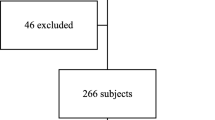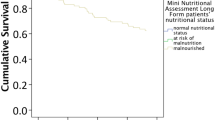Abstract
Objectives
To identify independent risk factors of mortality among elderly patients in the 3 months after their visit (T3) to an emergency department (ED).
Design
Prospective cohort study.
Setting
University hospital ED in an urban setting in France.
Participants
One hundred seventy-three patients aged 75 and older were admitted to the ED over two weeks (18.7% of the 924 ED visits). Of these, 164 patients (94.8%) were included in our study, and 157 (95.7%) of them were followed three months after their ED visit.
Measurements
During the inclusion period (T0), a standardized questionnaire was used to collect data on socio-demographic and environmental characteristics, ED visit circumstances, medical conditions and geriatric assessment including functional and nutritional status. Three months after the ED visits (T3), patients or their caregivers were interviewed to collect data on vital status, and ED return or hospitalization.
Results
Among the 157 patients followed at T3, 14.6% had died, 19.9% had repeated ED visits, and 63.1% had been hospitalized. The two independent predictive factors for mortality within the 3 months after ED visit were: malnutrition screened by the Mini Nutritional Assessment short-form (MNA-SF) (OR=20.2; 95% CI: 5.74–71.35; p<.001) and the Cumulative Illness Rating Scale for Geriatrics (CIRS-G) score (OR=1.1; 95% CI: 1.01–1.22; p=.024).
Conclusion
Malnutrition is the strongest independent risk factor predicting short-term mortality in elderly patients visiting the ED, and it was easily detected by MNA-SF and supported from the ED visit.
Similar content being viewed by others
References
Hoot NR, Aronsky D. Systematic review of emergency department crowding: causes, effects, and solutions. Ann Emerg Med 2008;52:126–136.
Derlet RW, Richards JR. Overcrowding in the nation’s emergency departments: complex causes and disturbing effects. Ann Emerg Med 2000;35:63–68.
McCaig LF, Nawar EW. National Hospital Ambulatory Medical Care Survey: 2004 emergency department summary. Adv Data 2006;23:1–29.
Roberts DC, McKay MP, Shaffer A. Increasing rates of emergency department visits for elderly patients in the United States, 1993 to 2003. Ann Emerg Med 2008;51:769–774.
Samaras N, Chevalley T, Samaras D, Gold G. Older patients in the emergency department: a review. Ann Emerg Med 2010;56:261–269.
Aminzadeh F, Dalziel WB. Older adults in the emergency department: a systematic review of patterns of use, adverse outcomes, and effectiveness of interventions. Ann Emerg Med 2002;39:238–247.
Rice DP, Fineman N. Economic implications of increased longevity in the United States. Annu Rev Public Health 2004;25:457–473.
Salvi F, Morichi V, Grilli A, Giorgi R, De Tommaso G, Dessì-Fulgheri P. The elderly in the emergency department: a critical review of problems and solutions. Intern Emerg Med 2007;2:292–301.
Grief CL. Patterns of ED use and perceptions of the elderly regarding their emergency care: a synthesis of recent research. J Emerg Nurs 2003;29:122–126.
Schumacher JG. Emergency medicine and older adults: continuing challenges and opportunities. Am J Emerg Med 2005;23:556–560.
Schumacher JG, Deimling GT, Meldon S, Woolard B. Older adults in the Emergency Department: predicting physicians’ burden levels. J Emerg Med 2006;30:455–460.
Schoevaerdts D, Biettlot S, Malhomme B, Rezette C, Gillet JB, Vanpee D, Cornette P, Swine C. Identification précoce du profil gériatrique en salle d’urgences: présentation de la grille SEGA. La revue de gériatrie 2004; 29: 169–178.
McCusker J, Bellavance F, Cardin S, Trepanier S, Verdon J, Ardman O. Detection of older people at increased risk of adverse health outcomes after an emergency visit: the ISAR screening tool. J Am Geriatr Soc 1999;47:1229–1237.
Veillette N, Demers L, Dutil E, McCusker J. Development of a functional status assessment of seniors visiting emergency department. Arch Gerontol Geriatr 2009;48:205–212.
Friedmann PD, Jin L, Karrison TG, Hayley DC, Mulliken R, Walter J, Chin MH. Early revisit, hospitalization, or death among older persons discharged from the ED. Am J Emerg Med 2001;19:125–129.
McCusker J, Healey E, Bellavance F, Connolly B. Predictors of repeat emergency department visits by elders. Acad Emerg Med 1997;4:581–588.
McCusker J, Cardin S, Bellavance F, Belzile E. Return to the emergency department among elders: patterns and predictors. Acad Emerg Med 2000;7:249–259.
Hastings SN, Schmader KE, Sloane RJ, Weinberger M, Goldberg KC, Oddone EZ. Adverse health outcomes after discharge from the emergency department—incidence and risk factors in a veteran population. J Gen Intern Med 2007;22:1527–1531.
Chin MH, Jin L, Karrison TG, Mulliken R, Hayley DC, Walter J, Miller A, Friedmann PD. Older patients’ health-related quality of life around an episode of emergency illness. Ann Emerg Med 1999;34:595–603.
Ballabio C, Bergamaschini L, Mauri S, Baroni E, Ferretti M, Bilotta C, Vergani C. A comprehensive evaluation of elderly people discharged from an Emergency Department. Intern Emerg Med 2008;3:245–249.
Caplan GA, Williams AJ, Daly B, Abraham K. A randomized, controlled trial of comprehensive geriatric assessment and multidisciplinary intervention after discharge of elderly from the emergency department—the DEED II study. J Am Geriatr Soc 2004;52:1417–1423.
Rowland K, Maitra AK, Richardson DA, Hudson K, Woodhouse KW. The discharge of elderly patients from an accident and emergency department: functional changes and risk of readmission. Age Ageing 19990;19:415–418.
Institut National de la Statistique et des Etudes Economiques. http://www.insee.fr/fr/ppp/bases-de-donnees/donnees-detaillees/duicq/pdf/ftd/ftd_z_9305030.pdf. Accessed 30 January 2012.
Journal Officiel de la République Française. Loi n°2004 — 806 du 9 août 2004 relative à la politique de santé publique. Protection des personnes en matière de santé. http://legifrance.gouv.fr/affichTexte.do?cidTexte=JORFTEXT000000787078. Accessed 31 January 2012.
Commission Nationale de l’Informatique et des Libertés. http://www.cnil.fr/vosresponsabilites/declarer-un-fichier/. Accessed 31 January 2012
Parmelee PA, Thuras PD, Katz IR, Lawton MP. Validation of the Cumulative Illness Rating Scale in a geriatric residential population. J Am Geriatr Soc 1995;43:130–137.
Salvi F, Miller MD, Grilli A, Giorgi R, Towers AL, Morichi V, Spazzafumo L, Mancinelli L, Espinosa E, Rappelli A, Dessì-Fulgheri P. A manual of guidelines to score the modified cumulative illness rating scale and its validation in acute hospitalized elderly patients. J Am Geriatr Soc 2008;56:1926–1931.
Kaiser MJ, Bauer JM, Ramsch C, Uter W, Guigoz Y, Cederholm T, Thomas DR, Anthony P, Charlton KE, Maggio M, Tsai AC, Grathwohl D, Vellas B, Sieber CC; MNA-International Group. Validation of the Mini Nutritional Assessment short-form (MNA-SF): a practical tool for identification of nutritional status. J Nutr Health Aging 2009;13:782–788.
Clément JP, Nassif RF, Léger JM, Marchan F. Development and contribution to the validation of a brief French version of the Yesavage Geriatric Depression Scale. Encephale 1997;23:91–99
Katz S, Ford AB, Moskowitz RW, Jackson BA, Jaffe MW. Studies of illness in the aged. The index of ADL: a standardized measure of biological and psychological function. JAMA 1963;185:914–919.
Collège National des enseignants de gériatrie, Module 5 (2010) Masson, Paris
Lawton MP, Brody EM. Assessment of older people: self-maintaining and instrumental activities of daily living. Gerontologist 1969;9:179–186.
Richardson DB. Elderly patients in the emergency department: a prospective study of characteristics and outcome. Med J Aust 1992;157:234–239.
Rosenfeld T, Fahey P, Price M, Leeder S. The fate of elderly patients discharged from the accident and emergency department of a general teaching hospital. Community Health Stud 1990;14:365–372.
Drame M, Jovenin N, Novella JL, Lang PO, Somme D, Laniece I, Voisin T, Blanc P, Couturier P, Gauvain JB, Blanchard F, Jolly D. Predicting early mortality among elderly patients hospitalised in medical wards via emergency department: the SAFES cohort study. J Nutr Health Aging 2008;12:599–604.
Correia MI, Waitzberg DL. The impact of malnutrition on morbidity, mortality, length of hospital stay and costs evaluated through a multivariate model analysis. Clin Nutr 2003;22:235–239.
Chan M, Lim YP, Ernest A, Tan TL. Nutritional assessment in an Asian nursing home and its association with mortality. J Nutr Health Aging 2010;14:23–28.
Salvi F, Morichi V, Grilli A, Giorgi R, De Tommaso G, Dessì-Fulgheri P. The elderly in the emergency department: a critical review of problems and solutions. Intern Emerg Med 2007;2:292–301.
Murphy MC, Brooks CN, New SA, Lumbers ML. The use of the Mini-Nutritional Assessment (MNA) tool in elderly orthopaedic patients. Eur J Clin Nutr 2000;54:555–562.
Saletti A, Lindgren EY, Johansson L, Cederholm T. Nutritional status according to mini nutritional assessment in an institutionalized elderly population in Sweden. Gerontology 2000;46:139–145.
Author information
Authors and Affiliations
Rights and permissions
About this article
Cite this article
Gentile, S., Lacroix, O., Durand, A.C. et al. Malnutrition: A highly predictive risk factor of short-term mortality in elderly presenting to the emergency department. J Nutr Health Aging 17, 290–294 (2013). https://doi.org/10.1007/s12603-012-0398-0
Received:
Accepted:
Published:
Issue Date:
DOI: https://doi.org/10.1007/s12603-012-0398-0




